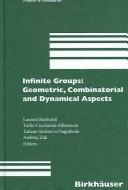| Listing 1 - 10 of 12 | << page >> |
Sort by
|
Book
ISBN: 9780387782157 0387782141 9780387782140 144192681X 9786611954253 128195425X 038778215X Year: 2008 Publisher: New York, NY : Springer New York : Imprint: Springer,
Abstract | Keywords | Export | Availability | Bookmark
 Loading...
Loading...Choose an application
- Reference Manager
- EndNote
- RefWorks (Direct export to RefWorks)
In this new textbook, acclaimed author John Stillwell presents a lucid introduction to Lie theory suitable for junior and senior level undergraduates. In order to achieve this, he focuses on the so-called "classical groups'' that capture the symmetries of real, complex, and quaternion spaces. These symmetry groups may be represented by matrices, which allows them to be studied by elementary methods from calculus and linear algebra. This naive approach to Lie theory is originally due to von Neumann, and it is now possible to streamline it by using standard results of undergraduate mathematics. To compensate for the limitations of the naive approach, end of chapter discussions introduce important results beyond those proved in the book, as part of an informal sketch of Lie theory and its history. John Stillwell is Professor of Mathematics at the University of San Francisco. He is the author of several highly regarded books published by Springer, including The Four Pillars of Geometry (2005), Elements of Number Theory (2003), Mathematics and Its History (Second Edition, 2002), Numbers and Geometry (1998) and Elements of Algebra (1994).
Mathematics. --- Topological Groups, Lie Groups. --- Topological Groups. --- Mathématiques --- Lie algebras. --- Lie groups. --- Lie algebras --- Lie groups --- Algebra --- Mathematics --- Physical Sciences & Mathematics --- Groups, Lie --- Algebras, Lie --- Topological groups. --- Symmetric spaces --- Topological groups --- Algebra, Abstract --- Algebras, Linear --- Groups, Topological --- Continuous groups

ISBN: 9780817645236 9780817643638 Year: 2008 Publisher: Boston, MA English Edition Birkhäuser Boston
Abstract | Keywords | Export | Availability | Bookmark
 Loading...
Loading...Choose an application
- Reference Manager
- EndNote
- RefWorks (Direct export to RefWorks)
D-modules continues to be an active area of stimulating research in such mathematical areas as algebra, analysis, differential equations, and representation theory. Key to D-modules, Perverse Sheaves, and Representation Theory is the authors' essential algebraic-analytic approach to the theory, which connects D-modules to representation theory and other areas of mathematics. Significant concepts and topics that have emerged over the last few decades are presented, including a treatment of the theory of holonomic D-modules, perverse sheaves, the all-important Riemann-Hilbert correspondence, Hodge modules, and the solution to the Kazhdan-Lusztig conjecture using D-module theory. To further aid the reader, and to make the work as self-contained as possible, appendices are provided as background for the theory of derived categories and algebraic varieties. The book is intended to serve graduate students in a classroom setting and as self-study for researchers in algebraic geometry, and representation theory.
Ordered algebraic structures --- Geometry --- algebra --- topologie (wiskunde) --- Topological groups. Lie groups --- Algebra --- landmeetkunde --- wiskunde --- Group theory --- Représentations d'algèbres de Lie --- Representations of Lie algebras --- Linear algebraic groups. --- D-modules. --- Representations of groups. --- Groupes algébriques linéaires --- D-modules, Théorie des --- Représentations de groupes --- Groupes algébriques linéaires --- D-modules, Théorie des --- Représentations de groupes
Book
ISBN: 9783642156274 9783642156267 3642156266 3642156274 Year: 2011 Publisher: Berlin, Heidelberg Springer Berlin Heidelberg
Abstract | Keywords | Export | Availability | Bookmark
 Loading...
Loading...Choose an application
- Reference Manager
- EndNote
- RefWorks (Direct export to RefWorks)
The classical geometries of points and lines include not only the projective and polar spaces, but similar truncations of geometries naturally arising from the groups of Lie type. Virtually all of these geometries (or homomorphic images of them) are characterized in this book by simple local axioms on points and lines. Simple point-line characterizations of Lie incidence geometries allow one to recognize Lie incidence geometries and their automorphism groups. These tools could be useful in shortening the enormously lengthy classification of finite simple groups. Similarly, recognizing ruled manifolds by axioms on light trajectories offers a way for a physicist to recognize the action of a Lie group in a context where it is not clear what Hamiltonians or Casimir operators are involved. The presentation is self-contained in the sense that proofs proceed step-by-step from elementary first principals without further appeal to outside results. Several chapters have new heretofore unpublished research results. On the other hand, certain groups of chapters would make good graduate courses. All but one chapter provide exercises for either use in such a course, or to elicit new research directions.
Topological groups. Lie groups --- topologie (wiskunde) --- Geometry --- geometrie --- Mathematics --- Géométrie --- Mathématiques --- EPUB-LIV-FT LIVMATHE LIVSTATI SPRINGER-B --- Geometric group theory. --- Lie groups. --- Geometry. --- Topological Groups. --- Topological Groups, Lie Groups. --- Euclid's Elements --- Groups, Topological --- Continuous groups --- Mathematics. --- Topological groups. --- Groups, Lie --- Lie algebras --- Symmetric spaces --- Topological groups
Book
ISSN: 00725285 ISBN: 9781848009882 9781848009875 1848009879 9786613562142 1848009887 1280384220 1447125274 Year: 2009 Volume: 251 Publisher: London : Springer London : Imprint: Springer,
Abstract | Keywords | Export | Availability | Bookmark
 Loading...
Loading...Choose an application
- Reference Manager
- EndNote
- RefWorks (Direct export to RefWorks)
The finite simple groups are the building blocks from which all the finite groups are made and as such they are objects of fundamental importance throughout mathematics. The classification of the finite simple groups was one of the great mathematical achievements of the twentieth century, yet these groups remain difficult to study which hinders applications of the classification. This textbook brings the finite simple groups to life by giving concrete constructions of most of them, sufficient to illuminate their structure and permit real calculations both in the groups themselves and in the underlying geometrical or algebraic structures. This is the first time that all the finite simple groups have been treated together in this way and the book points out their connections, for example between exceptional behaviour of generic groups and the existence of sporadic groups, and discusses a number of new approaches to some of the groups. Many exercises of varying difficulty are provided. The Finite Simple Groups is aimed at advanced undergraduate and graduate students in algebra as well as professional mathematicians and scientists who use groups and want to apply the knowledge which the classification has given us. The main prerequisite is an undergraduate course in group theory up to the level of Sylow’s theorems.
Mathematics. --- Group Theory and Generalizations. --- Topological Groups, Lie Groups. --- Group theory. --- Topological Groups. --- Mathématiques --- Groupes, Théorie des --- Finite simple groups --- Groupes simples finis --- Mathematics --- Algebra --- Physical Sciences & Mathematics --- Finite simple groups. --- Théorie des groupes --- Math --- Simple groups, Finite --- Algebra. --- Topological groups. --- Lie groups. --- Science --- Finite groups --- Linear algebraic groups --- Groups, Topological --- Continuous groups --- Groups, Theory of --- Substitutions (Mathematics) --- Mathematical analysis --- Groups, Lie --- Lie algebras --- Symmetric spaces --- Topological groups

ISBN: 1280608889 9786610608881 3764374470 3764374462 9783764374464 9783764374471 Year: 2005 Publisher: Basel Birkhäuser Verlag
Abstract | Keywords | Export | Availability | Bookmark
 Loading...
Loading...Choose an application
- Reference Manager
- EndNote
- RefWorks (Direct export to RefWorks)
This book offers a panorama of recent advances in the theory of infinite groups. It contains survey papers contributed by leading specialists in group theory and other areas of mathematics. Topics addressed in the book include amenable groups, Kaehler groups, automorphism groups of rooted trees, rigidity, C*-algebras, random walks on groups, pro-p groups, Burnside groups, parafree groups, and Fuchsian groups. The accent is put on strong connections between group theory and other areas of mathematics, such as dynamical systems, geometry, operator algebras, probability theory, and others. This interdisciplinary approach makes the book interesting to a large mathematical audience. Contributors: G. Baumslag A.V. Borovik T. Delzant W. Dicks E. Formanek R. Grigorchuk M. Gromov P. de la Harpe A. Lubotzky W. Lück A.G. Myasnikov C. Pache G. Pisier A. Shalev S. Sidki E. Zelmanov.
Infinite groups. --- Ergodic theory. --- Selfadjoint operators. --- Differential topology. --- Geometry, Differential --- Topology --- Operators, Selfadjoint --- Self-adjoint operators --- Linear operators --- Ergodic transformations --- Continuous groups --- Mathematical physics --- Measure theory --- Transformations (Mathematics) --- Groups, Infinite --- Group theory --- Group theory. --- Topological Groups. --- Combinatorics. --- Operator theory. --- Global differential geometry. --- Algebraic topology. --- Group Theory and Generalizations. --- Topological Groups, Lie Groups. --- Operator Theory. --- Differential Geometry. --- Algebraic Topology. --- Functional analysis --- Combinatorics --- Algebra --- Mathematical analysis --- Groups, Topological --- Groups, Theory of --- Substitutions (Mathematics) --- Topological groups. --- Lie groups. --- Differential geometry. --- Differential geometry --- Groups, Lie --- Lie algebras --- Symmetric spaces --- Topological groups

ISBN: 3764377917 9783764377908 3764377909 9783764377915 Year: 2007 Publisher: Basel Birkhäuser Verlag AG
Abstract | Keywords | Export | Availability | Bookmark
 Loading...
Loading...Choose an application
- Reference Manager
- EndNote
- RefWorks (Direct export to RefWorks)
The use of Clifford algebras in mathematical physics and engineering has grown rapidly in recent years. Whereas other developments have privileged a geometric approach, the author uses an algebraic approach which can be introduced as a tensor product of quaternion algebras and provides a unified calculus for much of physics. The book proposes a pedagogical introduction to this new calculus, based on quaternions, with applications mainly in special relativity, classical electromagnetism and general relativity. The volume is intended for students, researchers and instructors in physics, applied mathematics and engineering interested in this new quaternionic Clifford calculus.
Clifford algebras. --- Quaternions. --- Algebra, Universal --- Algebraic fields --- Curves --- Surfaces --- Numbers, Complex --- Vector analysis --- Geometric algebras --- Algebras, Linear --- Algebra. --- Group theory. --- Topological Groups. --- Mathematical physics. --- Classical and Quantum Gravitation, Relativity Theory. --- Associative Rings and Algebras. --- Group Theory and Generalizations. --- Topological Groups, Lie Groups. --- Mathematical Methods in Physics. --- Physical mathematics --- Physics --- Groups, Topological --- Continuous groups --- Groups, Theory of --- Substitutions (Mathematics) --- Algebra --- Mathematics --- Mathematical analysis --- Gravitation. --- Associative rings. --- Rings (Algebra). --- Topological groups. --- Lie groups. --- Physics. --- Field theory (Physics) --- Matter --- Antigravity --- Centrifugal force --- Relativity (Physics) --- Natural philosophy --- Philosophy, Natural --- Physical sciences --- Dynamics --- Groups, Lie --- Lie algebras --- Symmetric spaces --- Topological groups --- Algebraic rings --- Ring theory --- Rings (Algebra) --- Properties
Book
ISBN: 9780387788357 0387788344 9780387788340 0387788352 9786611954338 1281954330 Year: 2008 Volume: 251 Publisher: New York, NY : Springer New York : Imprint: Springer,
Abstract | Keywords | Export | Availability | Bookmark
 Loading...
Loading...Choose an application
- Reference Manager
- EndNote
- RefWorks (Direct export to RefWorks)
This book treats Jacques Tits's beautiful theory of buildings, making that theory accessible to readers with minimal background. It includes all the material of the earlier book Buildings by the second-named author, published by Springer-Verlag in 1989, which gave an introduction to buildings from the classical (simplicial) point of view. This new book also includes two other approaches to buildings, which nicely complement the simplicial approach: On the one hand, buildings may be viewed as abstract sets of chambers with a Weyl-group-valued distance function; this point of view has become increasingly important in the theory and applications of buildings. On the other hand, buildings may be viewed as metric spaces. Beginners can still use parts of the new book as a friendly introduction to buildings, but the book also contains valuable material for the active researcher. There are several paths through the book, so that readers may choose to concentrate on one particular approach. The pace is gentle in the elementary parts of the book, and the style is friendly throughout. All concepts are well motivated. There are thorough treatments of advanced topics such as the Moufang property, with arguments that are much more detailed than those that have previously appeared in the literature. This book is suitable as a textbook, with many exercises, and it may also be used for self-study.
Buildings (Group theory) --- Immeubles (Théorie des groupes) --- Buildings (Group theory). --- Algebra --- Mathematics --- Physical Sciences & Mathematics --- Linear algebraic groups. --- Immeubles (Théorie des groupes) --- EPUB-LIV-FT LIVMATHE LIVSTATI SPRINGER-B --- Theory of buildings (Group theory) --- Tits's theory of buildings (Group theory) --- Algebraic groups, Linear --- Mathematics. --- Algebraic geometry. --- Group theory. --- Topological groups. --- Lie groups. --- Group Theory and Generalizations. --- Algebraic Geometry. --- Topological Groups, Lie Groups. --- Geometry, Algebraic --- Group theory --- Algebraic varieties --- Linear algebraic groups --- Geometry, algebraic. --- Topological Groups. --- Groups, Topological --- Continuous groups --- Algebraic geometry --- Geometry --- Groups, Theory of --- Substitutions (Mathematics) --- Groups, Lie --- Lie algebras --- Symmetric spaces --- Topological groups
Book
ISBN: 9780387798523 9780387798516 038779851X 1441927298 9786612290527 1282290525 0387798528 Year: 2009 Publisher: New York, NY Springer-Verlag New York
Abstract | Keywords | Export | Availability | Bookmark
 Loading...
Loading...Choose an application
- Reference Manager
- EndNote
- RefWorks (Direct export to RefWorks)
Symmetry is a key ingredient in many mathematical, physical, and biological theories. Using representation theory and invariant theory to analyze the symmetries that arise from group actions, and with strong emphasis on the geometry and basic theory of Lie groups and Lie algebras, Symmetry, Representations, and Invariants is a significant reworking of an earlier highly-acclaimed work by the authors. The result is a comprehensive introduction to Lie theory, representation theory, invariant theory, and algebraic groups, in a new presentation that is more accessible to students and includes a broader range of applications. The philosophy of the earlier book is retained, i.e., presenting the principal theorems of representation theory for the classical matrix groups as motivation for the general theory of reductive groups. The wealth of examples and discussion prepares the reader for the complete arguments now given in the general case. Key Features of Symmetry, Representations, and Invariants: • Early chapters suitable for honors undergraduate or beginning graduate courses, requiring only linear algebra, basic abstract algebra, and advanced calculus • Applications to geometry (curvature tensors), topology (Jones polynomial via symmetry), and combinatorics (symmetric group and Young tableaux) • Self-contained chapters, appendices, comprehensive bibliography • More than 350 exercises (most with detailed hints for solutions) further explore main concepts • Serves as an excellent main text for a one-year course in Lie group theory • Benefits physicists as well as mathematicians as a reference work.
algebra --- topologie (wiskunde) --- Mathematical physics --- Topological groups. Lie groups --- Algebra --- wiskunde --- Group theory --- fysica --- Representations of groups --- Invariants --- Symmetry (Mathematics) --- Lie groups --- Représentations de groupes --- Analyse multidimensionnelle --- Symétrie (Mathématiques) --- Groupes de Lie --- Algèbre --- EPUB-LIV-FT LIVMATHE LIVSTATI SPRINGER-B --- Representations of groups. --- Invariants. --- Symmetry (Mathematics). --- Algebra. --- Lie groups. --- Group theory. --- Geometry. --- Mathematical physics. --- Topological Groups. --- Group Theory and Generalizations. --- Mathematical Methods in Physics. --- Topological Groups, Lie Groups. --- General Algebraic Systems. --- Groups, Topological --- Continuous groups --- Physical mathematics --- Physics --- Mathematics --- Euclid's Elements --- Mathematical analysis --- Groups, Theory of --- Substitutions (Mathematics) --- Physics. --- Topological groups. --- Groups, Lie --- Lie algebras --- Symmetric spaces --- Topological groups --- Natural philosophy --- Philosophy, Natural --- Physical sciences --- Dynamics
Book
ISBN: 9780817682712 9780817682705 0817682708 0817682716 Year: 2012 Publisher: Boston Birkhäuser Boston
Abstract | Keywords | Export | Availability | Bookmark
 Loading...
Loading...Choose an application
- Reference Manager
- EndNote
- RefWorks (Direct export to RefWorks)
This textbook gives a concise introduction to the theory of differentiable manifolds, focusing on their applications to differential equations, differential geometry, and Hamiltonian mechanics. The work’s first three chapters introduce the basic concepts of the theory, such as differentiable maps, tangent vectors, vector and tensor fields, differential forms, local one-parameter groups of diffeomorphisms, and Lie derivatives. These tools are subsequently employed in the study of differential equations (Chapter 4), connections (Chapter 5), Riemannian manifolds (Chapter 6), Lie groups (Chapter 7), and Hamiltonian mechanics (Chapter 8). Throughout, the book contains examples, worked out in detail, as well as exercises intended to show how the formalism is applied to actual computations and to emphasize the connections among various areas of mathematics. Differentiable Manifolds is addressed to advanced undergraduate or beginning graduate students in mathematics or physics. Prerequisites include multivariable calculus, linear algebra, differential equations, and (for the last chapter) a basic knowledge of analytical mechanics.
mechanica --- Differential topology --- wiskunde --- Mathematical physics --- Topological groups. Lie groups --- topologie (wiskunde) --- topologie --- Classical mechanics. Field theory --- Differentiable manifolds --- Cell aggregation --- Mechanics. --- Mathematical physics. --- Topological Groups. --- Manifolds and Cell Complexes (incl. Diff.Topology). --- Classical Mechanics. --- Mathematical Methods in Physics. --- Topological Groups, Lie Groups. --- Mathematics. --- Groups, Topological --- Continuous groups --- Physical mathematics --- Physics --- Classical mechanics --- Newtonian mechanics --- Dynamics --- Quantum theory --- Aggregation, Cell --- Cell patterning --- Cell interaction --- Microbial aggregation --- Mathematics --- Manifolds (Mathematics). --- Complex manifolds. --- Physics. --- Topological groups. --- Lie groups. --- Groups, Lie --- Lie algebras --- Symmetric spaces --- Topological groups --- Natural philosophy --- Philosophy, Natural --- Physical sciences --- Analytic spaces --- Manifolds (Mathematics) --- Geometry, Differential --- Topology --- 515.16 --- Differential manifolds --- 515.16 Topology of manifolds --- Topology of manifolds

ISBN: 9780817682088 1461264936 9781461264934 0817633391 0817682082 Year: 2005 Publisher: Boston, MA : Birkhäuser Boston : Imprint: Birkhäuser,
Abstract | Keywords | Export | Availability | Bookmark
 Loading...
Loading...Choose an application
- Reference Manager
- EndNote
- RefWorks (Direct export to RefWorks)
One of the mathematical challenges of modern physics lies in the development of new tools to efficiently describe different branches of physics within one mathematical framework. This text introduces precisely such a broad mathematical model, one that gives a clear geometric expression of the symmetry of physical laws and is entirely determined by that symmetry. The first three chapters discuss the occurrence of bounded symmetric domains (BSDs) or homogeneous balls and their algebraic structure in physics. It is shown that the set of all possible velocities is a BSD with respect to the projective group; the Lie algebra of this group, expressed as a triple product, defines relativistic dynamics. The particular BSD known as the spin factor is exhibited in two ways: first, as a triple representation of the Canonical Anticommutation Relations, and second, as a ball of symmetric velocities. The associated group is the conformal group, and the triple product on this domain gives a representation of the geometric product defined in Clifford algebras. It is explained why the state space of a two-state quantum mechanical system is the dual space of a spin factor. Ideas from Transmission Line Theory are used to derive the explicit form of the operator Mobius transformations. The book further provides a discussion of how to obtain a triple algebraic structure associated to an arbitrary BSD; the relation between the geometry of the domain and the algebraic structure is explored as well. The last chapter contains a classification of BSDs revealing the connection between the classical and the exceptional domains. With its unifying approach to mathematics and physics, this work will be useful for researchers and graduate students interested in the many physical applications of bounded symmetric domains. It will also benefit a wider audience of mathematicians, physicists, and graduate students working in relativity, geometry, and Lie theory.
Mathematics. --- Applications of Mathematics. --- Mathematical Methods in Physics. --- Geometry. --- Classical and Quantum Gravitation, Relativity Theory. --- Topological Groups, Lie Groups. --- Differential Geometry. --- Topological Groups. --- Global differential geometry. --- Mathematical physics. --- Mathématiques --- Géométrie --- Géométrie différentielle globale --- Physique mathématique --- Homogeneous spaces. --- Mathematical physics -- Mathematical models. --- Special relativity (Physics). --- Topological groups. --- Engineering & Applied Sciences --- Applied Mathematics --- Homogeneous spaces --- Mathematical physics --- Special relativity (Physics) --- Applied Physics --- Mathematical models --- Mathematical models. --- Ether drift --- Mass energy relations --- Relativity theory, Special --- Restricted theory of relativity --- Special theory of relativity --- Physical mathematics --- Physics --- Spaces, Homogeneous --- Mathematics --- Lie groups. --- Applied mathematics. --- Engineering mathematics. --- Differential geometry. --- Physics. --- Gravitation. --- Relativity (Physics) --- Lie groups --- Geometry, Differential --- Groups, Topological --- Continuous groups --- Euclid's Elements --- Math --- Science --- Differential geometry --- Groups, Lie --- Lie algebras --- Symmetric spaces --- Topological groups --- Field theory (Physics) --- Matter --- Antigravity --- Centrifugal force --- Natural philosophy --- Philosophy, Natural --- Physical sciences --- Dynamics --- Engineering --- Engineering analysis --- Mathematical analysis --- Properties
| Listing 1 - 10 of 12 | << page >> |
Sort by
|

 Search
Search Feedback
Feedback About UniCat
About UniCat  Help
Help News
News